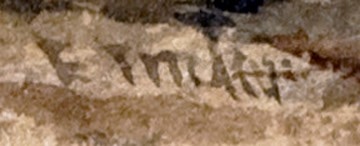Lake District Scene,
|
Research by Hilary Alcock and Marjorie Gregson
|

ARTIST
Descended from a Devonshire family, Edward Tucker was born in London c1816, his father being a barrister.At the outset of his career he was placed under the instruction of Thomas A Woolnoth, a renowned engraver of the day. However, his artistic ability developed in another direction and he rose to considerable eminence as a painter, excelling in both landscapes and seascapes. Tucker also spent much of his time sketching on the Continent. He counted the artist William Etty amongst his friends. He married Julia Mary Maile, a fellow artist, and they had five sons, all of whom were taught to paint by their parents. In order not to be confused with their father, three of them were known by other names. Because of this confusion many art websites vary in the dates of Edward Senior’s birth and death but census returns and obituary notices are more reliable. Edward Tucker Junior 1848-1909 (Edward Arden) Alfred Robert Tucker 1849-1914 (Alfred Maile) Bishop of Uganda Hubert Tucker 1851-1921 (Hubert Coutts) Frederick Tucker 1854-1935 Arthur Bristol Tucker 1864-1929 According to Arthur P Shepherd, Alfred Maile’s biographer, "the boys all worked together in one large studio under the criticism of their parents and the frank comments of one another, and their artistic talents developed rapidly”. As their parents didn’t have enough income the family moved from place to place in order to make a living. Around 1865 Edward Senior took up residence in the Lake District, living in Langdale for many years before moving to Windermere, where he became known as the “Artist of Windermere”. Four of his sons were founder members of the Lake Artists Society and Hubert was its first President. Alfred had joined the church, became a Canon of Durham Cathedral and later Bishop of Uganda. Edward worked mainly in watercolours and several of his paintings were hung in the Royal Academy. Art historians are frequently unsure which paintings should be attributed to father and which to son. There is an oil painting attributed to Edward Tucker in Dartmouth Museum labelled Dartmouth Harbour from Castle Walk, Devon 1835. This was purchased by The Friends of Dartmouth Borough Museum for £240 from a London gallery in 1963. The chairman of Dartmouth Museum, Commander David Lingard, informed us that there is some doubt over the artist’s name and date as, according to one of their members, the artist was Edwin Tucker. Edward’s obituary in the Westmorland Gazette of 18 June 1898 stated that he was a man “devoted to his art and being of a modest and gentle disposition, he took little or no part in public affairs”. He was buried in Windermere Cemetery, the officiating clergy being from St John’s Church, Bowness in Windermere, which he had attended. PAINTING Originally entitled “Coniston, near Brantwood 188?”, it is now thought to be the Langdale Pikes, as several viewers had pointed out that it definitely was not the Old Man of Coniston. Dr Ian Milner, a retired local GP familiar with the Lake District setting, has suggested the hills rising majestically in the background are most likely the crags of Langdale Pikes with Pavey Arc to the right. REFERENCES findmypast.co.uk/census/newspapers Westmorland Gazette, 18 June 1898 www.artuk.org http://dartmouthmuseum.org |
Acc No 126 Artist Edward Tucker Senior Artist dates 1825-1909 Medium watercolour Size 5.25 x 8.5 in (13.34 x 21.59 cm) Date painted c1880 Donor Emily Green (1868-1951) 19 York Road, Lytham St Annes Date donated 1951 Emily also donated another painting by Tucker Lake District Scene, View of Dunmail Raise, Acc No 114 2 by E Myers Coastal Scene with Shipping, Acc No 129 Coastal Scene with Shipping 1873 Acc No 125 2 by George Baxter Lake Lucerne June 1857 Acc No 122 North Italian Lakes Acc no 124 - unlocated at present time |

